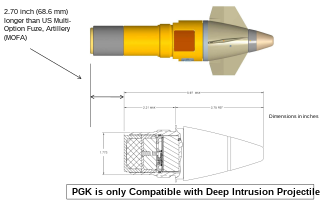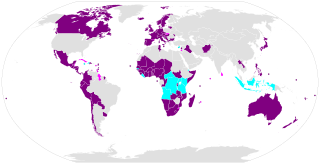
A cluster munition is a form of air-dropped or ground-launched explosive weapon that releases or ejects smaller submunitions. Commonly, this is a cluster bomb that ejects explosive bomblets that are designed to kill personnel and destroy vehicles. Other cluster munitions are designed to destroy runways or electric power transmission lines.

A mortar is today usually a simple, lightweight, man-portable, muzzle-loaded cannon, consisting of a smooth-bore metal tube fixed to a base plate with a lightweight bipod mount and a sight. Mortars are typically used as indirect fire weapons for close fire support with a variety of ammunition. Historically mortars were heavy siege artillery. Mortars launch explosive shells in high-arching ballistic trajectories.

A shell, in a military context, is a projectile whose payload contains an explosive, incendiary, or other chemical filling. Originally it was called a bombshell, but "shell" has come to be unambiguous in a military context. A shell can hold a tracer.

Unexploded ordnance, unexploded bombs (UXBs), and explosive remnants of war are explosive weapons that did not explode when they were employed and still pose a risk of detonation, sometimes many decades after they were used or discarded. When unwanted munitions are found, they are sometimes destroyed in controlled explosions, but accidental detonation of even very old explosives also occurs, sometimes with fatal results. A dud is an unexploded projectile fired in anger against an enemy, but which has failed to explode. A projectile not fired in anger but which has failed to explode is called a 'blind'.

The CBU-97 Sensor Fuzed Weapon is a United States Air Force 1,000-pound (450 kg)-class freefall Cluster Bomb Unit. It was developed and produced by Textron Defense Systems. A CBU-97 used in conjunction with the Wind Corrected Munitions Dispenser guidance tail kit is converted to a precision-guided weapon, and the combination is designated CBU-105.

The JP233, originally known as the Low-Altitude Airfield Attack System(LAAAS), is a British submunition delivery system. It consists of large dispenser pods carrying several hundred submunitions designed to attack runways.

A dual-purpose improved conventional munition (DPICM) is an artillery or surface-to-surface missile warhead designed to burst into submunitions at an optimum altitude and distance from the desired target for dense area coverage. The submunitions use both shaped charges for the anti-armor role, and fragmentation for the antipersonnel role, hence the nomenclature "dual-purpose". Some submunitions may be designed for delayed reaction or mobility denial (mines). The air-to-surface variety of this kind of munition is better known as a cluster bomb. They are banned by more than 100 countries under the Convention on Cluster Munitions.

The XM395 Precision Guided Mortar Munition (PGMM) is a 120 mm guided mortar round developed by Alliant Techsystems.
The Type 84 is a Chinese air-dispersed scatterable anti-tank mine, normally deployed by the GBL212 122 mm artillery rocket, or the Type 122-15 ATML rocket for export versions. Each rocket can carry six or eight mines and has a range of around six or seven kilometres. The rockets are launched from a BM-21 Grad multiple rocket launcher system that can hold up to 24 of the rockets. A time fuse on the rocket is set before launch, which activates at a predetermined distance after firing. Upon activation, the rocket head bursts, ejecting the mines, which descend with small green parachutes that slow their fall. The mine consists of a cylindrical body with three prong legs that form a spike, which pierces the ground and arms. If the mine strikes soft ground, the spike is driven into the ground and the mine is held upright.

The M1156 Precision Guidance Kit (PGK), formerly XM1156, is a U.S. Army-designed precision guidance system to turn existing 155 mm artillery shells into smart weapons. The prime contractor was Alliant Techsystems – later merging with Orbital Sciences Corporation to form Orbital ATK, in turn being taken over by Northrop Grumman and renamed Northrop Grumman Innovation Systems – and the industry team includes Interstate Electronics Corporation. By April 2018, more than 25,000 PGKs had been produced.

The Convention on Cluster Munitions (CCM) is an international treaty that prohibits all use, transfer, production, and stockpiling of cluster munitions, a type of explosive weapon which scatters submunitions ("bomblets") over an area. Additionally, the convention establishes a framework to support victim assistance, clearance of contaminated sites, risk reduction education, and stockpile destruction. The convention was adopted on 30 May 2008 in Dublin, and was opened for signature on 3 December 2008 in Oslo. It entered into force on 1 August 2010, six months after it was ratified by 30 states. As of December 2023, a total of 124 states are committed to the goal of the convention, with 112 states that have ratified it, and 12 states that have signed the convention but not yet ratified it.a

Ammunition is the material fired, scattered, dropped, or detonated from any weapon or weapon system. Ammunition is both expendable weapons and the component parts of other weapons that create the effect on a target.
In military munitions, a fuze is the part of the device that initiates its function. In some applications, such as torpedoes, a fuze may be identified by function as the exploder. The relative complexity of even the earliest fuze designs can be seen in cutaway diagrams.

A precision-guided munition (PGM), also called a smart weapon, smart munition, or smart bomb, is a guided munition intended to hit a specific target, to minimize collateral damage and increase lethality against intended targets. During the Persian Gulf War guided munitions accounted for only 9% of weapons fired, but accounted for 75% of all successful hits. Despite guided weapons generally being used on more difficult targets, they were still 35 times more likely to destroy their targets per weapon dropped.

An artillery fuze or fuse is the type of munition fuze used with artillery munitions, typically projectiles fired by guns, howitzers and mortars. A fuze is a device that initiates an explosive function in a munition, most commonly causing it to detonate or release its contents, when its activation conditions are met. This action typically occurs a preset time after firing, or on physical contact with or detected proximity to the ground, a structure or other target. Fuze, a variant of fuse, is the official NATO spelling.

Instalaza SA is a Spanish firm that designs, develops and manufactures equipment and other military material for infantry. The company, founded in 1943, is headquartered in Zaragoza, Aragon, where its production plant is also located.
The SMArt 155 is a German 155 mm artillery round designed for a long-range, indirect fire top-attack role against armoured vehicles. The projectile was developed in 1989 by Diehl BGT Defence in Überlingen, Germany, with Rheinmetall and started full-rate production for the German Army in 1998. It consists of a 47-kilogram (104 lb) heavy artillery projectile containing two autonomous, sensor-fused, "fire-and-forget" submunitions. Due to the submunitions, it has been considered by some to be a cluster munition. As of 2008, representatives of the German defense ministry have referred to it as not being classified as submunition weapons, which were prohibited by the 2008 Convention on Cluster Munitions.
The 120 mm M984 extended-range DPICM mortar round was developed by the US Army Ordnance. It is a 120mm caliber mortar cluster munition that can carry a variety of payloads including either 54 M80 dual-purpose submunitions or six mines. It can be optionally used with a range extending rocket in a tractor configuration which increases its range from 7.2 to around 12 kilometers.

The use of cluster munitions during the Russian invasion of Ukraine (2022–present) has been recorded by a number of eyewitnesses and journalists, as well as representatives of the UN, humanitarian and public organizations. In particular, the head of the UN Human Rights Council, Michelle Bachelet, reported on March 30 at least 24 cases since the beginning of the invasion. As of July 1, hundreds of attacks by Russian forces with cluster munitions have already been recorded in the settlements of the Dnipropetrovsk, Donetsk, Zaporizhzhia, Kyiv, Luhansk, Mykolaiv, Odesa, Sumy, Kharkiv, Kherson and Chernihiv regions. 215 civilians are known to have been killed in these shellings and 474 injured, many of which may go unreported. Both Russia as well as Ukraine have used cluster munitions during the conflict, however, Russian use has been extensive while Ukrainian use has been more limited.

The 9N24 sub-munition is of Soviet-era design and is used most often with the OTR-21 Tochka, NATO reporting name SS-21 Scarab. This type of cluster bomb munition would be prevented by the 2008 Convention on Cluster Munitions were Russia to be a signatory, which it is not.















